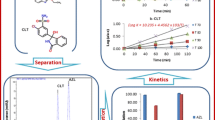Abstract
A forced degradation study on ropinirole hydrochloride in bulk and in its modified release tablets was conducted under the conditions of hydrolysis, oxidation and photolysis in order to develop an isocratic stability-indicating LC-UV method for quantification of the drug in tablets. An impurity peak in standard solution was found to increase under acidic and neutral hydrolytic conditions while another degradation product was formed under alkaline condition. The drug and its degradation products were optimally resolved on a Hypersil C18 column with mobile phase composed of diammonium hydrogen orthophosphate (0.05 M; pH 7.2), tetrahydrofuran and methanol (80:15:5% v/v) at a flow rate of 1.0 mL min−1 at 30 °C using 250 nm as detection wavelength. The method was linear in the range of 0.05–50 μg mL−1 drug concentrations. The %RSD of inter- and intra-day precision studies was <1. The system suitability parameters remained unaffected during quantification of the drug on three different LC systems. Excellent recoveries (101.59–102.28%) proved that the method was sufficiently accurate. The LOD and LOQ were found to be 0.012 and 0.040 μg mL−1, respectively. Degradation behaviour of the drug in both bulk and tablets was similar. The drug was very unstable to hydrolytic conditions but stable to oxidative and photolytic conditions. The method can be used for rapid and accurate quantification of ropinirole hydrochloride in tablets during stability testing. Based on chemical reactivity of ropinirole in different media, the degradation products were suspected to be different from the known impurities of the drug.



Similar content being viewed by others
References
Kurzel MD (1999) Am J Health Syst Pharm 56:217–224
Rascol O, Lees AJ, Senard JM (1996) Clin Neuropharmacol 19:234–245
Matsukawa N, Maki M, Yasuhara T, Hara K, Yu G, Xu L et al (2007) Brain Res 1160:113–123. doi:10.1016/j.brainres.2007.05.030
Brooks DJ, Abbott RJ, Lees AJ (1998) Clin Neuropharmacol 2:101–107
March J (1992) Advanced Organic Chemistry. Reactions, mechanisms and structure, 4th edn. Wiley-Interscience, New York, pp 383–386
Challis BC, Challis JA (1970) Reactions of the carboxamide group. In: Zabicky IJ (ed) The Chemistry of Amides: Reactions of the carboxamide group. Intersciences Publisher, London, pp 731–857
Lwowski W (1984) Reactivity of small and large rings. In: Lwowski W (ed) Comprehensive heterocyclic chemistry. The structure, reactions, synthesis and uses of heterocyclic compounds. Pergamon Press, Oxford, pp 17–29
ICH (2003) Stability testing of new drug substances and products. In: International conference on harmonization, IFPMA, Geneva
ICH (2006) Impurities in new drug substances. In: International conference on harmonization, IFPMA, Geneva
ICH (2006) Impurities in new drug products. In: International conference on harmonization, IFPMA, Geneva
Susheel JV, Malathi S, Ravi TK (2007) Indian J Pharm Sci 69:589–591
Aydogmus Z (2008) Spectrochim Acta A Mol Biomol Spectrosc 70:69–78. doi:10.1016/j.saa.2007.07.012
Swagzdis J, Mico B (1986) J Pharm Sci 75:90–91. doi:10.1002/jps.2600750122
Onal A (2006) Chromatographia 64:459–461. doi:10.1365/s10337-006-0045-1
Bhatta J, Jangida A, Shettya R, Shaha B, Kamblia S, Subbaiaha G et al (2006) J Pharm Biomed Anal 40:1202–1208. doi:10.1016/j.jpba.2005.09.024
Coufal P, Stulík K, Claessens HA, Hardy MJ, Webb M (1999) J Chromatogr B Biomed Sci Appl 732:437–444. doi:10.1016/S0378-4347(99)00314-X
Sahasrabuddheya B, Nautiyala R, Acharyab H, Khyadea S, Luthrab PK, Deshpande PB (2007) J Pharm Biomed Anal 43:1587–1593. doi:10.1016/j.jpba.2006.11.030
ICH (1996) Photostability testing of new drug substances and products. In: International conference on harmonization, IFPMA, Geneva
ICH (2005) Validation of analytical procedures: Text and methodology. In: International conference on harmonization, IFPMA, Geneva
Bakshi M, Singh S (2002) J Pharm Biomed Anal 28:1011–1040. doi:10.1016/S0731-7085(02)00047-X
Acknowledgments
The authors are thankful to Prof. Bhupinder Singh Bhoop, University Institute of Pharmaceutical Sciences, Panjab University, Chandigarh (India) and to Dr. R. K. Goel, Ms. Dimple Chopra and Ms. Kanchan Vohra, Department of Pharmaceutical Sciences and Drug Research, Punjabi University, Patiala (India) for their timely help in statistical evaluation of the data.
Author information
Authors and Affiliations
Corresponding author
Rights and permissions
About this article
Cite this article
Parmar, G., Sharma, S., Singh, K. et al. Forced Degradation Study to Develop and Validate Stability-Indicating RP-LC for Quantification of Ropinirole Hydrochloride in Its Modified Release Tablets. Chroma 69, 199–206 (2009). https://doi.org/10.1365/s10337-008-0866-1
Received:
Revised:
Accepted:
Published:
Issue Date:
DOI: https://doi.org/10.1365/s10337-008-0866-1




